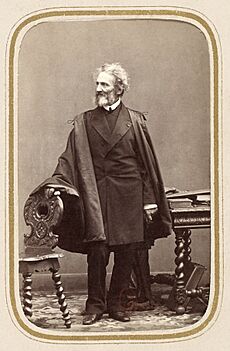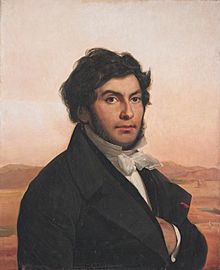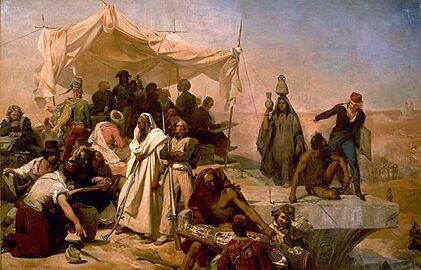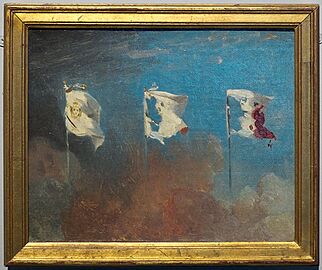Léon Cogniet facts for kids
Quick facts for kids
Léon Cogniet
|
|
|---|---|
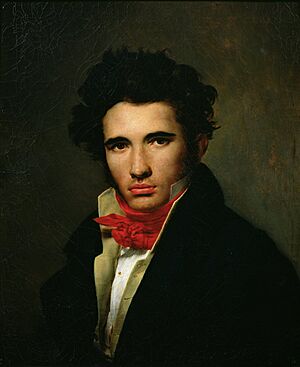
Léon Cogniet. Self-portrait c. 1818
|
|
| Born |
Léon Cogniet
29 August 1794 Paris, France
|
| Died | 20 November 1880 (aged 86) Paris, France
|
| Education | Pierre-Narcisse Guérin |
| Known for | Painting |
| Movement | Romanticism |
Léon Cogniet (born August 29, 1794 – died November 20, 1880) was a French artist. He painted historical scenes and portraits. He is most famous for being a teacher. Over one hundred well-known artists learned from him.
Contents
About Léon Cogniet
Léon Cogniet was born in Paris, France. His father was also a painter and designed wallpaper. In 1812, Léon joined the École des Beaux-arts. This was a famous art school in Paris. He studied there with a well-known artist named Pierre-Narcisse Guérin.
In 1817, Léon won the Prix de Rome. This was a very important art prize. It allowed him to study art in Rome, Italy, until 1822. Before he left, he showed his paintings at the Salon. This was a big art exhibition in Paris.
His Artworks
In 1827, Cogniet painted a series of murals. These were large wall paintings. They showed the life of Saint Stephen for a church in Paris. From 1833 to 1835, he painted a huge scene for the Louvre Museum. This painting was on a ceiling. It showed Napoleon's journey to Egypt.
After 1855, Léon Cogniet mostly stopped painting. He focused more on teaching.
His Teaching Career
From 1840 to 1860, Léon Cogniet ran a popular painting workshop. This workshop was especially for women. His sister, Marie Amélie Cogniet, helped him run it. One of his students, Catherine Caroline Thévenin, later became his wife.
After 1843, he spent almost all his time teaching. He would sometimes paint a portrait. He taught design at the Lycée Louis-le-Grand after 1831. He also taught at the École polytechnique from 1847 to 1861.
In 1851, he became a professor at the École des Beaux-arts. He held this important job until 1863. After he retired, he became more private. He passed away in Paris in 1880. He is buried in the Père-Lachaise Cemetery. His sister, Marie Amélie Cogniet, was also a painter.
Famous Paintings
Here are some of Léon Cogniet's well-known paintings:
History Paintings
- La Garde nationale de Paris part pour l’armée, Septembre 1792 (The Paris National Guard on its way to the Army, September 1792)
- Tintoretto painting his dead daughter (1843; Musée des Beaux-Arts de Bordeaux)
- Scenes of July 1830
- Les Drapeaux, 1830. This painting shows the flags after the "Three Glorious Days" of the 1830 Revolution. It shows the old white flag being torn. This reveals the blue sky and a red color spreading. Together, these colors create the Republic's tricolor flag.
Portraits
- Maréchal Maison
- Louis Philippe
- M. de Crillon
- Jean-François Champollion
Gallery
-
The Egyptian Expedition Under the Command of Bonaparte, ceiling at the Louvre, 1835
Notable Students
Léon Cogniet taught many students who became famous artists. Here are some of them:
- Pedro Américo
- Félix-Joseph Barrias
- Louis-Ernest Barrias
- Émile Bayard
- François-Léon Benouville
- Émile Bin
- Nils Blommér
- Rosa Bonheur
- Léon Bonnat
- Alfred Boucher
- Marie-Abraham Rosalbin de Buncey
- Adolphe-Félix Cals
- Henriette Cappelaere
- Henri Chapu
- François Chifflart
- Pierre Auguste Cot
- Alfred Darjou
- Alfred de Dreux
- Alfred Dehodencq
- Godefroy Durand
- Louis Duveau
- Augustin Feyen-Perrin
- Claude Ferdinand Gaillard
- Wojciech Gerson
- Karl Girardet
- Eugène Ernest Hillemacher
- Jean-Paul Laurens
- Jules Lefebvre
- Diogène Maillart
- Francisco Masias Rodriguez
- Oscar-Pierre Mathieu
- Constant Mayer
- Jean-Louis-Ernest Meissonier
- Hugues Merle
- Charles Louis Müller
- Ion Negulici
- Victor Nehlig
- Dominique Papety
- Henri Félix Emmanuel Philippoteaux
- Paul Philippoteaux
- Adolphe Piot
- Gustav Richter
- Tony Robert-Fleury
- Henryk Rodakowski
- Louis Rubio
- Eugénie Salanson
- August Friedrich Schenck
- Hippolyte Sebron
- Alexandre Ségé
- Charles Sellier


